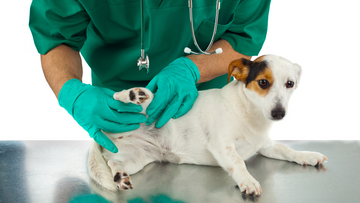Just like people, dogs can develop diabetes. Understanding the causes of this disease is the first step to giving your pup the best care possible. Canine diabetes is more common than many dog owners realize. While it's a lifelong condition, it can be managed successfully with the right support, information, and care. So, what exactly causes diabetes in dogs?
What is Canine Diabetes?

Canine diabetes is typically diabetes mellitus, which occurs when the body doesn’t produce enough insulin or stops responding to insulin the way it should. Insulin is the hormone that helps cells absorb sugar from the bloodstream and use it for energy. Without enough insulin, sugar builds up in the blood. This can lead to a variety of symptoms and potential health complications.
There are two main types of diabetes in dogs:
-
Type I (insulin-dependent): This is the most common type in dogs and occurs when the pancreas stops producing insulin altogether.
-
Type II (non-insulin-dependent): Rare in dogs but common in cats, this type happens when the body still makes insulin but doesn’t use it correctly.
Common Causes of Diabetes in Dogs
While diabetes can affect any dog, certain factors can increase the risk. Here are the most common causes and risk factors.
Genetics
Some dogs are predisposed to diabetes because of their breed or family history. Breeds like Miniature Schnauzers, Poodles, Dachshunds, Samoyeds, and terriers tend to have higher rates of diabetes. If you have one of these breeds, it’s good to be aware of early signs.
Obesity
One of the leading preventable causes of diabetes is excess weight. Just like in humans, obesity in dogs can lead to insulin resistance. Excess fat changes how the body uses insulin, which can result in diabetes. Feeding a healthy diet and providing regular exercise is crucial for keeping your dog in shape and their blood sugar levels stable.
Age & Gender
Most cases of canine diabetes develop between 5 and 12 years old. As dogs age, their metabolism slows down, and their risk for various health issues increases, including diabetes. Unspayed female dogs are more likely to develop diabetes than males. Hormonal changes can interfere with insulin sensitivity, especially during heat cycles or pregnancy. Spaying can help reduce this risk.
Other Health Conditions
Certain medical conditions can affect insulin production. Some of these conditions include:
-
Pancreatitis (inflammation of the pancreas) can damage insulin-producing cells.
-
Cushing’s disease causes excess cortisol production, which can lead to insulin resistance.
-
Steroid medications used to treat inflammation or allergies can also interfere with insulin regulation if used long-term.
Can Diabetes in Dogs Be Prevented?
While not all cases can be prevented, especially if it’s genetic, you can lower your dog’s risk by:
-
Maintaining a healthy weight.
-
Feeding a balanced, high-quality diet.
-
Keeping up with regular vet checkups.
-
Spaying your female dogs.
-
Paying attention to changes in behavior, energy levels, or bathroom habits.
Warning Signs of Diabetes in Dogs
Early detection makes a big difference. Common symptoms of diabetes in dogs include increased thirst and urination, weight loss despite a good appetite, fatigue or lethargy, and cloudy eyes. If your dog shows any of these signs, a trip to the vet is the best next step! A simple blood or urine test can confirm what’s going on. Diabetes in dogs can be caused by a mix of genetics, lifestyle, and age. A diabetes diagnosis is not necessarily a life sentence. With early detection and good management, diabetic dogs can live happy, healthy lives!





















